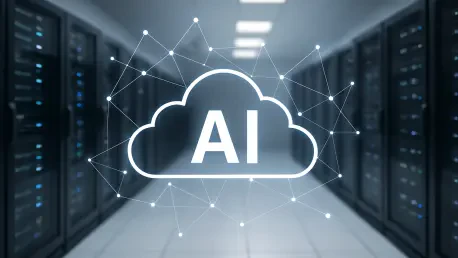What happens when the relentless demand for artificial intelligence computing power pushes global data center infrastructure to the breaking point, leaving even the largest facilities struggling to keep up? In 2025, the AI revolution is not just reshaping industries—it’s exposing critical weaknesses in traditional hyperscale data centers that can’t scale fast enough to meet the needs of compute-intensive workloads. This crisis has paved the way for an innovative solution: neocloud services, specialized cloud platforms designed to tackle AI’s unique challenges head-on. With cutting-edge technology and a laser focus on high-performance computing, these services are redefining how businesses and researchers power their most ambitious projects.
The importance of this shift cannot be overstated. As AI applications like machine learning, blockchain processing, and scientific simulations dominate the tech landscape, the strain on power, cooling, and deployment timelines has created an urgent need for alternatives. Neoclouds aren’t just filling a gap—they’re transforming the data center industry by offering tailored solutions that traditional providers can’t match. This feature delves into how these specialized services are becoming indispensable, exploring their unique capabilities, industry insights, and practical strategies for organizations navigating the AI-driven world.
The AI Explosion: Straining Traditional Data Centers
The surge in AI adoption has unleashed an unprecedented appetite for computing resources, particularly graphics processing units (GPUs), which are essential for training complex models. Traditional hyperscale data centers, built for generalized cloud services, often falter under this pressure due to limitations in electricity supply and inadequate cooling systems for high-density hardware. Reports indicate that many facilities face delays of several years in expanding capacity, leaving businesses and research teams in a bind as they scramble to keep pace with innovation.
This bottleneck has far-reaching implications across sectors. Startups developing generative AI tools, for instance, find themselves unable to secure the necessary infrastructure, stalling product launches and competitive growth. Meanwhile, scientific institutions running simulations for drug discovery or climate modeling are forced to ration resources, slowing critical advancements. The gap between demand and supply has never been more evident, setting the stage for a new kind of solution to emerge in response to these pressing challenges.
Why AI Needs a Different Infrastructure Approach
AI workloads differ fundamentally from standard cloud computing tasks, requiring immense processing power and specialized hardware that traditional setups struggle to provide. Machine learning models, for example, demand GPUs running at full throttle, generating heat and power draws that exceed the design limits of many existing data centers. This mismatch often results in inefficiencies, with some facilities unable to support racks consuming over 50 kW, let alone the 100 kW needed for cutting-edge AI systems.
Beyond hardware, the speed of deployment is another hurdle. Hyperscale providers, constrained by sprawling, multi-purpose architectures, can take years to build or retrofit sites for AI-specific needs, a timeline that clashes with the rapid iteration cycles of tech innovators. This reality has driven a growing number of organizations to seek alternatives that prioritize agility and performance, highlighting a clear demand for infrastructure built from the ground up to handle the unique rigors of AI applications.
Neoclouds: Tailored Powerhouses for AI Demands
Neocloud services stand out as a targeted answer to these challenges, offering GPU-as-a-Service (GPUaaS) alongside infrastructure optimized for extreme computing environments. These platforms boast racks capable of handling over 100 kW of power, supported by advanced immersion cooling systems that manage the intense heat output of GPU clusters. Unlike hyperscalers, neocloud providers can deploy new sites in mere months, a game-changing advantage for time-sensitive projects.
Cost efficiency further sets neoclouds apart, with GPU instance pricing reportedly up to 66% lower than that of major hyperscale competitors. This affordability, paired with structural designs supporting floor loads of 12-15 kN/m², makes them ideal for niche but critical applications like AI training and gaming platforms. A notable case involves a mid-sized AI startup that slashed development costs by partnering with a neocloud provider, scaling its model training capacity overnight without the burden of long-term capital investments.
Industry projections underscore this momentum, estimating a compound annual growth rate of 82% for neocloud services from 2025 to 2027. Such growth reflects not just market demand but also the strategic focus on greenfield projects—new builds designed specifically for high-density rack systems like Nvidia’s latest architectures. This specialization positions neoclouds as indispensable allies in powering the next wave of AI breakthroughs.
Industry Perspectives: The Neocloud Disruption
Expert voices from the field provide a deeper understanding of this transformative shift. Muhd Syafiq, a data center analyst at JLL, emphasizes the agility of neoclouds, noting, “Their ability to spin up GPU-centric environments in months, not years, addresses a critical pain point for AI-driven enterprises.” This speed, combined with localized expertise in site selection, enables neoclouds to navigate power and zoning constraints more effectively than larger, less nimble competitors.
Alexander Harrowell of Omdia offers a complementary view, framing neoclouds as a financial innovation as much as a technical one. “They often operate as a form of vendor financing, backed by GPU manufacturers and AI research labs, spreading the cost of cutting-edge hardware across users,” Harrowell explains. This model reduces barriers for smaller players, as seen in the experience of a university research team that accessed top-tier GPU resources through a neocloud provider, scaling simulations without the prohibitive upfront expense.
These insights reveal a broader consensus: neoclouds complement rather than compete with hyperscalers, carving out a niche where high-performance computing reigns supreme. Their role as a flexible, cost-effective bridge for AI workloads is reshaping how the industry approaches infrastructure, balancing immediate needs with long-term scalability.
Practical Steps for Leveraging Neoclouds in AI Strategies
For organizations aiming to harness AI’s potential, integrating neocloud services offers tangible benefits through strategic planning. One key approach is to prioritize providers with flexible contract durations, typically spanning two to five years, which align with the unpredictable timelines of AI projects. This adaptability ensures resources can be scaled up or down without the rigidity of decade-long commitments often required by traditional data centers.
Another consideration is selecting neocloud partners with proven expertise in advanced cooling technologies, essential for sustaining GPU-intensive operations without downtime. Companies should also focus on providers capable of rapid site setup, a critical factor for meeting tight deadlines in competitive markets. For instance, a gaming platform recently leveraged a neocloud’s quick deployment to launch a new multiplayer feature ahead of schedule, gaining a significant edge over rivals.
Balancing the higher initial costs of neocloud services against their potential for premium returns is equally vital. Organizations are advised to conduct thorough cost-benefit analyses, factoring in the savings from reduced GPU instance pricing and the ability to avoid long-term infrastructure investments. By aligning with neocloud providers that match specific project needs, businesses and research entities can optimize their AI infrastructure for both efficiency and impact.
As the dust settled on the early battles of the AI infrastructure crisis, neocloud services had clearly emerged as a pivotal force in addressing the overwhelming demands of high-performance computing. Their specialized focus on GPU-centric solutions, rapid deployment capabilities, and cost efficiencies had redefined the landscape, offering a lifeline to organizations constrained by traditional data center limitations. Looking ahead, the challenge shifted to ensuring broader access to these platforms, with a focus on streamlining partnerships and reducing entry barriers for smaller innovators. The next steps involved fostering collaboration between neocloud providers, industry stakeholders, and policymakers to secure sustainable power sources and zoning solutions, ensuring that the momentum of AI innovation continued unabated into the future.









